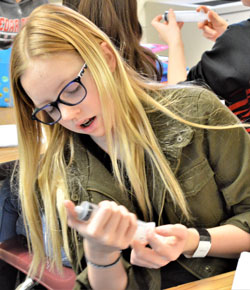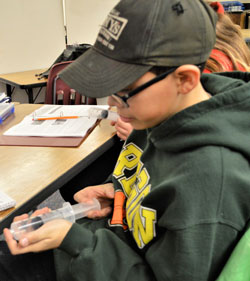Sixth-graders in a Red Hawk Elementary School science classroom pushed on the little plungers inside syringes and considered: What do you feel against your finger when you push the plunger? If you pushed harder would it blow the top off? Would you be able to push the plunger all the way in?
Questions like this are common at the school, where students are not given definitions of terms such as compression, condensation and evaporation, but rather are first expected to discover the concepts on their own.

Students are routinely given a hands-on activity to record observations as teacher Mackenzie Scott helps guide their thought processes.
Air, unlike water, which was used in a similar experiment a day or two earlier, can be compressed, said sixth-grader Tyson Van Sprange. When Scott confirmed that Tyson was correct, students returned to their notebooks, where they had recorded their observations and answered the daily questions.
Now they recorded the scientific definition of compression, which was added to growing list of characteristics of gases, said Scott.
Doing Science Like the Pros
The science program, IIQWST, which was piloted last year at Red Hawk, is now in its first full year. The curriculum aligns with Next Generation Science Standards, a set of teaching guidelines for kindergarten through 12th-graders outlined in “A Framework for K-12 Science Education.” NGSS standards are based on learning through experimentation that isn’t cut and dry. Students redesign, rebuild and tweak as many times as it takes, filling data notebooks with information as they go. They propose answers, state a claim, provide evidence and support it.
Students seem pleased with the opportunity to work like real scientists. “It is interesting that you can’t push it all the way in,” said sixth-grader Avery Lake referring to the plunger. “I kind of knew that air takes up space, but this is different.”

“It is nice to be able to figure it out yourself and it is easier to remember when you figure it out,” said sixth-grader Addison Jones.
Their teacher agrees the program is effective. “I love it,” said Scott. “It is really hand- on and lets the students do the discovering, and even they recognize that it a good way to learn it.”
Even though many of the daily activities are just small things, students readily respond to experience of being in a lab setting, according to Scott.
“They love having beakers, lab sheets and things like that. It helps spark a love for science, and I like that,” she said.
As students discover the characteristics of gases, the scientific definitions are presented and put on display in the classroom to ensure accuracy and review.
CONNECT













